
Tumacácori National Historical Park is located in the upper Santa Cruz River Valley in Santa Cruz County, southern Arizona. The park consists of 360 acres (1.5 km2) in three separate units. The park protects the ruins of three Spanish mission communities, two of which are National Historic Landmark sites. It also contains the landmark 1937 Tumacácori Museum building, also a National Historic Landmark.

The following list presents the full set of National Register of Historic Places listings in Multnomah County, Oregon. However, please see separate articles for listings in each of Portland's six quadrants.

The North State Street Historic District is a nationally designated historic district in Monticello, Piatt County, Illinois. The residential district is centered on State Street north of downtown Monticello; it includes 77 buildings, 56 of which are considered contributing to its historic character. The houses in the district represent the variety of architectural styles seen in Monticello from 1870 to 1948, the ages of the oldest and newest houses. The oldest houses in the district are designed in the Gothic Revival and Queen Anne styles. In the early 20th century, Monticello experienced an economic boom due to growth in agriculture and the local patent medicine industry; its newly wealthy residents built homes on State Street, which became known locally as "Millionaire's Row". The majority of these new homes had Colonial Revival designs, as the style was nationally popular at the time; Colonial Revival is still the district's predominant architectural style. Other designs featured in the district include Craftsman, Tudor Revival, and a Lustron house built in 1948. The district also includes several vernacular house types, such as the I-house and the bungalow.

The Riverside Historic District is a U.S. historic district located in downtown Evansville, Indiana. It was added to the register in 1978 and roughly bounded by Southlane Drive, Walnut, Third, and Parrett Streets. It consists of 1,010 acres (4.1 km2) and 425 buildings. It is also known as the Riverside Neighborhood.
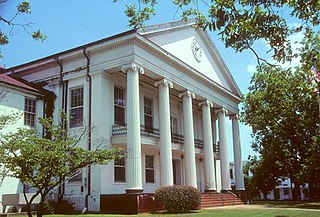
The Marion Courthouse Square Historic District is a historic district in Marion, Alabama. It is centered on the Perry County Courthouse and includes examples of Greek Revival, Gothic Revival, and Tudor Revival architecture. The boundaries are roughly along Green, Washington, Jefferson, Jackson, Franklin, Clements, Centreville and Monroe Streets. It was added to the National Register of Historic Places on February 16, 1996.

There are nine historic districts in Meridian, Mississippi. Each of these districts is listed on the National Register of Historic Places. One district, Meridian Downtown Historic District, is a combination of two older districts, Meridian Urban Center Historic District and Union Station Historic District. Many architectural styles are present in the districts, most from the late 19th century and early 20th century, including Queen Anne, Colonial Revival, Italianate, Art Deco, Late Victorian, and Bungalow.

There are 75 properties listed on the National Register of Historic Places in Albany, New York, United States. Six are additionally designated as National Historic Landmarks (NHLs), the most of any city in the state after New York City. Another 14 are historic districts, for which 20 of the listings are also contributing properties. Two properties, both buildings, that had been listed in the past but have since been demolished have been delisted; one building that is also no longer extant remains listed.

The Court Square–Dexter Avenue Historic District is a 17.6-acre (7.1 ha) historic district in downtown Montgomery, Alabama, United States. Centered on the Court Square Fountain, the district includes twenty-seven contributing buildings and two objects. It is roughly bounded by Dexter Avenue, Perry, Court and Monroe streets. Architectural styles in the district include Italianate, Late Victorian, and various Revival styles. It was placed on the National Register of Historic Places on March 1, 1982. The boundaries were subsequently increased on August 30, 1984.

The Dowe Historic District is a 1-acre (0.40 ha) historic district in Montgomery, Alabama. It includes 320 and 334 Washington Avenue and 114–116 South Hull Street. The architectural style of the four contributing buildings ranges from Greek Revival to Queen Anne. The district was placed on the National Register of Historic Places on December 29, 1988.

The Garden District is a 315-acre (127 ha) historic district in Montgomery, Alabama.
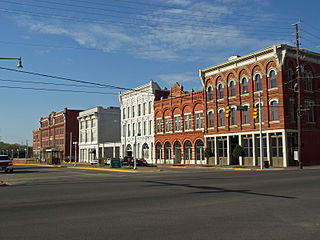
The Lower Commerce Street Historic District is a 45-acre (18 ha) historic district in the old commercial district of Montgomery, Alabama. It includes fifty-two contributing buildings. It is roughly bounded by the Central of Georgia railroad tracks, North Lawrence Street, Madison Avenue, and Commerce Street. Architectural styles in the district include the Italianate, Classical Revival, and Renaissance Revival. It was placed on the National Register of Historic Places on March 29, 1979, the boundaries were subsequently increased on February 25, 1982, and January 15, 1987.
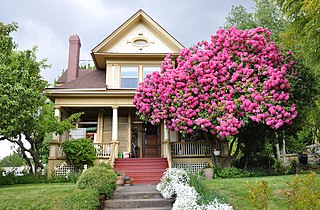
The William O. Munsell House in southeast Portland in the U.S. state of Oregon is a 1.5-story single dwelling listed on the National Register of Historic Places. Built in an eclectic mixture of Bungalow, American Craftsman, and Colonial Revival styles in 1902, it was added to the register in 1989.
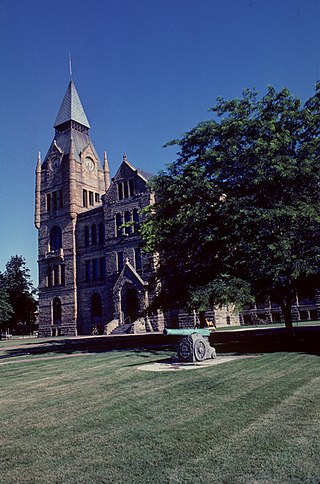
The Galesburg Historic District is a 496-acre (201 ha) historic district in Galesburg, Illinois. The district includes 1049 contributing buildings and contains the town's original plat as well as several older neighborhoods. The section of the district south of North Street encompasses Galesburg's historic city center and its most significant landmarks, such as the Knox County Courthouse, the Knox County Jail, the Burlington Depot, and Main Street's commercial buildings. Knox College, the school Galesburg was founded to serve, and its historic Old Main are also located in the southern half of the district. The area north of North Street is mainly residential and is dominated by Queen Anne and Classical Revival houses, including many transitional houses displaying elements of both styles.

The Howard Gardner Nichols Memorial Library is a historic building in Gadsden, Alabama, United States. The library was built in 1902 by the Nichols family, owners of the Dwight Manufacturing Company. It is named in honor of their son, who was badly injured while supervising the construction of the company's mill in what was then Alabama City. He died several days later.

The Alabama City Wall Street Historic District is a historic district in Gadsden, Alabama. Wall Street was the main commercial street in the town of Alabama City. The city was founded in 1891 halfway between Gadsden and Attalla, with intentions of becoming the major industrial hub of Northeast Alabama. In 1895 the town landed its first major concern, a cotton mill built by the Dwight Manufacturing Company of Chicopee, Massachusetts. Its second major factory, the Alabama Steel and Wire Company, was opened in 1902. By 1915, a thriving commercial district had grown up around 7th Avenue, which became known as "Little Wall Street". A fire in 1927 damaged or destroyed many structures along Wall Street and Meighan Avenue. The city would never recover from the loss, especially as neighboring Gadsden flourished; Alabama City voted to merge into Gadsden in 1932. The architecture of the district represent the changing commercial styles of the 1910s through the 1930s. Most are constructed in simple, brick styles with parapet roofs, some with more decorative brickwork. Art Deco-influenced features such as terra cotta coping and glass tile accents are present on later buildings. Other notable buildings are an Art Deco fire station and the Classical Revival library. The district was listed on the National Register of Historic Places in 2002.
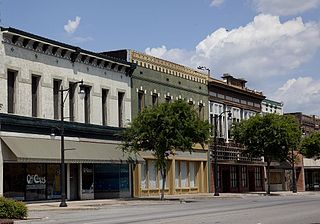
The Gadsden Downtown Historic District is a historic district in Gadsden, Alabama. The district represents the growth of the town through its industrial heyday from the late 1870s to the late 1940s. The earliest buildings in the district include examples of highly decorated Italianate styles, including the 1904 Gadsden Times-News Building. Early 20th-century buildings began showing less applied decoration, instead drawing visual variety from the brickwork itself. Later buildings begin to incorporate modern materials in their construction, including concrete, decorative glass, and enameled panels. There are three significant churches in the district that represent revivalist architectural styles:the Gothic Revival First Methodist Church, the Neoclassical First Baptist Church, and the Romanesque St. James Catholic Church. The Post Office and Courthouse, built in 1910, exhibits Italian Renaissance Revival style. The district was listed on the National Register of Historic Places in 1997.

The Gadsden Times-News Building is a historic building in Gadsden, Alabama. It was built by the owners of The Gadsden Times-News in 1904. After changing their name to The Gadsden Times in 1924, the paper moved its operation to another building in 1927. It has since housed a variety of commercial businesses. The two-story building is brick and rounded on the street corner. The 4th Street ground-level façade has cast iron pilasters and entablature, with large windows surrounded by smaller panes. The second floor has a series of arched one-over-one sash windows and a cornice with heavy modillions, which is raised on the curve. The building was listed on the Alabama Register of Landmarks and Heritage in 1982 and the National Register of Historic Places in 1983.
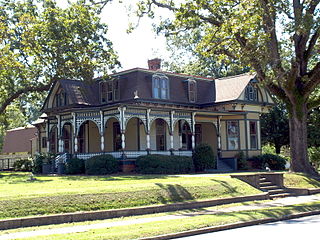
The Charles Gunn House is a historic residence in Gadsden, Alabama. The house was built in 1886 by Edward Tracy Hollingsworth, a local merchant and banker. Charles Logan Gunn, a dentist, purchased the house in 1901. His daughter, Carolyn Gunn Bellenger inherited the house, and willed it to the city upon her death in 1990. The city restored the house and now rents it for meetings and events.

The Colonel O. R. Hood House is a historic residence in Gadsden, Alabama. The house was built in 1904 by Oliver Roland Hood, an attorney, politician, industrialist, and one of the founders of the Alabama Power Company. He was also a delegate to the state's 1901 constitutional convention. It was designed and constructed by architect/builder James Crisman. Upon Hood's death in 1951, the house was purchased by the Woman's Club of Gadsden, a community service organization. The house is built in Classical Revival style with some Victorian details. The façade is dominated by a double-height portico supported by four Ionic columns. The front door is flanked by wide sidelights and a tall transom. The house also has two side entrances on octagonal bays at the rear of each side. The house was listed on the Alabama Register of Landmarks and Heritage in 1985 and the National Register of Historic Places in 1986.

The College Place Historic District is a historic district in Florence, Alabama. The area was the site of a Confederate fortification during the Civil War. In 1882 the land was purchased by Judge J. J. Mitchell and used as pasture land; Mitchell's house sits on Wood Avenue to the east of the district. The property began to be sold off in the 1900s, with the oldest house in the district dating to 1907. Construction in the district accelerated in the mid- to late-1920s, with many professionals including physicians, merchants, scientists, and attorneys building homes in the neighborhood. Styles represented include Mission Revival, Georgian Revival, and bungalows. The district rises on a slight slope above the campus of the University of North Alabama, and has vistas of the campus including Wesleyan Hall. The district was listed on the Alabama Register of Landmarks and Heritage in 1992 and the National Register of Historic Places in 1995; the boundaries were extended in 1998.
























